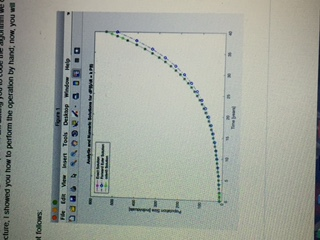Question
Population growth modeled via differential equation: (5) where P(t)= individuals in a population as function of time t, k= proportionality constant. Consider population growth as
Population growth modeled via differential equation:  (5)
(5)
where P(t)= individuals in a population as function of time t, k= proportionality constant. Consider population growth as follows
 is 0.1; the units for
is 0.1; the units for  are 1/year.
are 1/year.
initial time  is 0 years.
is 0 years.
final time  is 40 years.
is 40 years.
The initial population  is 10 individuals.
is 10 individuals.
Assume that no individuals leave the population during the time interval of interest.
1. Analytically solve this population growth problem using the techniques of calculus. just need to write Eqtn. 5 in the form  and integrate both sides. Do not submit any written analysis for this task, though you will use this information for other portions of this problem.
and integrate both sides. Do not submit any written analysis for this task, though you will use this information for other portions of this problem.
2. solve this population growth problem using the forward Euler integration technique. Use a time step size of 2 years. Store your derivative term in an anonymous function and use that anonymous function in your forward Euler solution implementation.
3. numerically solve this population growth problem using the built-in function ode45. Instead of using a separate programmer-defined function file, however, define your function inside the ode45 function call like ode45(@(t,p) your_function, ...)
4. Finally, plot the analytic result, the forward Euler solution, and the ode45 solution on the same plot. Include an appropriate title, an appropriate  -label, and
-label, and  label. Use different line colors and data markers for each line. Include a legend.
label. Use different line colors and data markers for each line. Include a legend.
(sample plot looks like)

PLEASE HELP
P(t) k P(t) P(t) k P(t)Step by Step Solution
There are 3 Steps involved in it
Step: 1

Get Instant Access to Expert-Tailored Solutions
See step-by-step solutions with expert insights and AI powered tools for academic success
Step: 2

Step: 3

Ace Your Homework with AI
Get the answers you need in no time with our AI-driven, step-by-step assistance
Get Started


